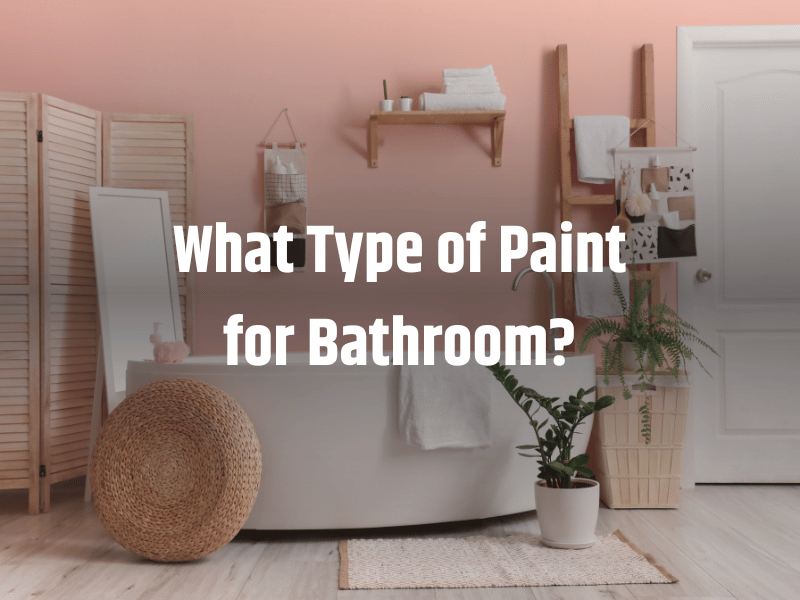
What Type of Paint for Bathroom?
Painting a bathroom is not just about choosing your favorite shade. Bathrooms are exposed to constant moisture, high humidity, and frequent cleaning, making them one of the most demanding spaces in your home when it comes to paint selection. If you’re wondering what type of paint for bathroom projects ensures durability, mold resistance, and visual appeal—this guide from S&E Remodeling covers everything you need to know.
Understanding Bathroom Conditions Before You Paint
Why Bathrooms Require Special Paint
Bathrooms are high-moisture zones. Steam from hot showers, splashes from the sink or tub, and lack of natural ventilation can quickly wear down conventional paint. This environment creates an ideal breeding ground for mold, mildew, and water damage unless proper products are used.
How Humidity and Moisture Affect Paint
Moisture seeps into porous paint finishes, causing bubbling, peeling, and discoloration. Over time, bathroom walls and ceilings can develop dark spots, odors, and even structural damage if the paint doesn’t provide a moisture barrier. Paint finishes lacking moisture resistance are especially vulnerable to mildew.
Common Problems
- Mold and mildew development
- Paint peeling or cracking
- Water stains on walls and ceilings
- Stale odor and wall deterioration
Importance of Using the Right Primer
Why Primer Is Essential in Bathrooms
Primer acts as a sealant and stabilizer. It improves paint adhesion, prevents stains from surfacing, and protects against humidity. In bathroom environments, using the wrong primer—or skipping it altogether—can shorten the life of your paint job. Certain bathroom primers are specially designed for this kind of space.
Types of Primers
- Mold-Resistant Primer: Contains fungicides that inhibit mold and mildew growth.
- Drywall Primer: Used in new construction to seal porous drywall surfaces before applying topcoat.
- All-Purpose Primer: Versatile but not always ideal for high-moisture rooms or bathroom paint applications.
Surface Preparation Tips
- Clean walls and ceilings thoroughly to remove soap residue and mildew
- Repair holes or cracks before applying primer
- Lightly sand glossy areas for better adhesion
- Ensure the room is dry before you begin painting
Why You Should Never Paint Over Existing Mildew
Painting over mildew doesn’t solve the problem. It traps mold underneath the surface, allowing it to grow and compromise your walls from within. Always remove mold completely using a bleach-water solution before priming and painting.
Choosing the Right Paint Base for Bathroom Walls and Ceilings
Comparing Paint Types
| Paint Type | Durability | VOC Levels | Drying Time | Cleaning Ease | Best For |
|---|---|---|---|---|---|
| Acrylic | High | Low | Fast | Easy | Full bathrooms, ceilings |
| Latex | High | Low | Fast | Easy | Powder rooms, general use |
| Oil-Based | Very High | High | Slow | Moderate | Cabinets, trim, high-traffic |
What Works Best Where:
- Steamy Full Baths: Acrylic paint or water-based latex paint
- Powder Rooms: Satin latex paint is sufficient
- Ceilings: Acrylic or mildew-resistant semi-gloss paint
- Cabinets & Trim: Durable oil-based paints or gloss paint
Both acrylic and latex paint options are ideal for bathroom conditions. Paint with additives for mold prevention further enhances moisture resistance, making them perfect for your bath environment. Knowing what type of paint for bathroom surfaces works best helps ensure long-lasting results.
Best Paint Finishes for Different Bathroom Surfaces
Walls
- Semi-gloss paint: Most recommended; resists moisture and scrubbing
- Satin finish: Offers a softer sheen and good cleanability
- Eggshell paint: Acceptable only in low-humidity powder rooms
Ceilings
- Satin or semi-gloss paint: Avoid flat paint; satin works for less humid rooms, semi-gloss for steamy spaces
Cabinets, Doors & Trim
- High-gloss latex paint: Excellent for frequent cleaning and water resistance
- Oil-based paints: Harder finish but longer drying time and higher VOCs
Finish Comparison Table
| Finish Type | Durability | Cleanability | Moisture Resistance | Sheen Level |
| Semi-Gloss | High | High | High | Medium-High |
| Satin | Medium | Medium | Medium | Medium |
| Eggshell | Low | Low | Low | Low |
| High-Gloss | Very High | Very High | Very High | High |
Bathroom paint finishes matter because the right finish will resist water and preserve the color longer. Understanding what type of paint for bathroom surfaces depends on function and environment.
Color Selection for Bathroom Paint
Light vs. Dark Tones
- Light Colors: Ideal for small bathrooms, reflects light to make space feel open
- Dark Colors: Adds drama and warmth to large bathrooms but can shrink small spaces visually
Factors to Consider
- Natural light: Brighter rooms can handle cooler or bolder shades
- Room size: Small rooms benefit from whites, creams, and light pastels
- Functionality: Main baths need lighter colors for easy visibility; powder rooms allow for creativity
Popular Color Schemes
- Neutral tones: White, beige, gray for timeless appeal
- Spa Vibes: Soft greens, sky blues, muted teals
- Bold Accent Walls: Deep navy, charcoal, forest green
Choosing what type of paint for bathroom walls includes selecting colors that suit your lighting and design goals. Use your bathroom’s size and fixtures to guide your color choices.
Mold and Mildew Prevention Tips
How to Protect Your Paint
- Select paints with added mildewcide formulas
- Ensure proper ventilation through exhaust fans or windows
- Use dehumidifiers in poorly ventilated bathrooms
- Reapply paint every few years in high-use bathrooms to keep protection intact
Warning Signs
- Peeling around baseboards or ceilings
- Persistent musty smells
- Recurring black or brown wall spots despite cleaning
Painting bathroom walls with the right gloss and water-resistant additives extends the life of your paint and helps maintain clean, healthy air. Always know what type of paint for bathroom protection you’re applying.
Bathroom Paint Application Tips from S&E Remodeling
Surface Prep Checklist
- Wash all walls and ceilings with water and mild detergent
- Eliminate any signs of mold or mildew with a bleach solution
- Patch holes and sand down rough spots
- Tape around fixtures and corners
Tools for Success
- Brush: For trim and edges
- Roller: For large wall and ceiling areas
- Foam roller: Best for smooth cabinet and door finishes
Drying & Recoating Guidelines
- Allow primer to dry 24 hours
- Apply two coats of paint for full coverage
- Wait at least 48 hours before using the shower to allow curing
Protecting Surrounding Areas
- Use drop cloths to shield flooring
- Cover fixtures and tiles with plastic sheeting
- Remove light switch covers and wall plates
If you’re unsure what type of paint for bathroom cabinets or ceilings to use, professional painters like S&E Remodeling can help ensure proper application.
Common Bathroom Paint Mistakes to Avoid
- Using flat paint in high-humidity areas
- Skipping primer, especially on glossy surfaces
- Ignoring ventilation, leading to premature paint failure
- Forgetting to paint ceilings and trims
- Painting over damp or moldy areas without proper cleaning
Avoiding these mistakes is just as important as knowing what type of paint for bathroom upgrades to choose.
Additional Design Tips for a Stunning Bathroom Finish
Smart Coordination
- Match or complement your paint with existing tile, vanity, and countertop colors
- Choose matching or contrasting hardware finishes (brushed nickel, matte black, brass)
Space-Enhancing Tricks
- Use vertical stripes or light hues to make a ceiling look taller
- Paint ceiling the same color as walls for a seamless effect
- Consider a statement wall in darker tones for visual interest
Trending Styles
- Modern: Matte black hardware, bold color contrasts, floating vanities
- Classic: Soft whites and greige tones with warm metallics
- Contemporary: Muted blue-greens with natural woodgrain textures
Adding complementary wall colors and sheens to coordinate with exterior house features can further tie the home together stylistically. When you understand what type of paint for bathroom design works best, you gain both function and beauty.
Why Homeowners Trust S&E Remodeling for Bathroom Renovations
At S&E Remodeling, we specialize in complete bathroom transformations that combine beauty and durability. Our team carefully selects the right paints, primers, and finishes to match your bathroom’s specific needs, ensuring long-lasting results and high resistance to moisture and daily wear.
Every worker at S&E Remodeling undergoes extensive training and industry certifications before stepping into your home. This commitment allows us to deliver exceptional workmanship that meets modern standards and exceeds client expectations.
We use state-of-the-art equipment and high-quality materials sourced directly from manufacturers. This ensures consistent quality while keeping costs competitive. Our company is fully licensed and certified by the Washington Department of Labor & Industries, under License Number SEREMRI822BE
Contact S&E Remodeling
Since 2018, S&E Remodeling Inc. has been serving homeowners across Western Washington and the Puget Sound area with pride and dedication. Founded by Yaniv Livnat, we’ve grown into a trusted name for bathroom, kitchen, and decking remodels.
What sets us apart is our commitment to honesty, integrity, and quality craftsmanship. Our customer base has grown largely through word-of-mouth, a testament to the trust and satisfaction we deliver.
We are a family-owned business that treats every client like one of our own. We never take shortcuts, and we always deliver on our promises. Ready to get started on your bathroom painting or remodeling project?
Call us today at (253) 364-4458. Let’s bring your vision to life—beautifully, efficiently, and professionally.

